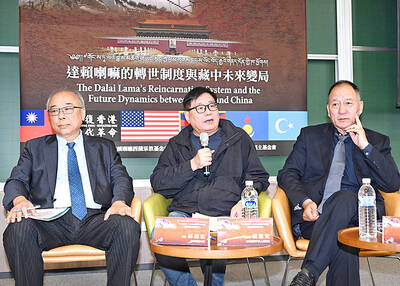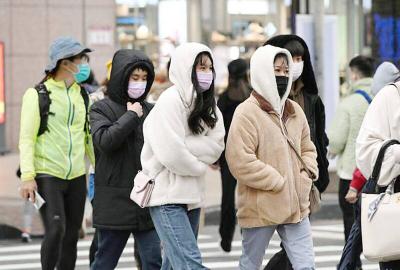Chris Chen, a former military captain, spent a lot of time waiting during his week-long training for reservists in June.
Waiting for assembly, waiting for lunch, waiting for training, he said.
The course, part of Taiwan’s efforts to deter a Chinese invasion, was jam-packed with 200 reservists to one instructor.

Photo: Sam Yeh, AFP
“It just became all listening, there was very little time to actually carry out the instructions,” Chen said.
Russia’s invasion of Ukraine has underscored the importance of mobilizing civilians when under attack, as Ukraine’s reserve forces helped fend off the invaders.
Nearly halfway around the world, it has highlighted Taiwan’s weaknesses on that front, chiefly in two areas: its reserves and civilian defense force.
While an invasion does not appear imminent, China’s large-scale military exercises shortly after a Taipei visit by US House of Representatives Speaker Nancy Pelosi last month made the government more aware than ever of the hard power behind Beijing’s rhetoric about bringing the nation under its control.
Experts said that civilian defense and reserve forces have an important deterrent effect, showing a potential aggressor that the risks of invasion are high. Even before the invasion of Ukraine in March, Taiwan was working on reforming both.
The question is whether it will be enough.
Taiwan’s reserves are meant to back up its 188,000-person military, which is 90 percent volunteers and 10 percent men doing their four months of compulsory military service.
On paper, the 2.3 million reservists enable Taiwan to match China’s 2 million-strong military.
Yet, the reserve system has long been criticized.
Many, like Chen, felt the seven days of training for the mostly former soldiers was a waste of time that did not prepare them well enough.
The number of combat-ready reservists — those who could immediately join frontline battles — is only about 300,000, said Democratic Progressive Party Legislator Wang Ting-yu (王定宇), who serves on the legislature’s Foreign Affairs and National Defense Committee.
“In Ukraine, if in the first three days of the war it had fallen apart, no matter how strong your military is, you wouldn’t have been able to fight the war,” Wang said. “A resilient society can meet this challenge. So that when you are met with disasters and war, you will not fall apart.”
Taiwan reorganized its reserve system in January, now coordinated by a new body called the All Out Defense Mobilization Agency, which is also to take over the civil defense system in an emergency.
One major change was the pilot launch of a more intensive, two-week training instead of the standard one week, which is to eventually be expanded to the 300,000 combat-ready reservists.
The remaining reservists can play a more defensive role, such as defending bridges, Wang said.
Dennis Shi in May joined the revamped training for two weeks at an abandoned building site on the northern coast.
Half the time it was raining; the rest, it was baking hot, he said.
The training coincided with the peak of a COVID-19 outbreak.
Wearing raincoats and masks, the reservists dug trenches and practiced firing mortars and marching.
“Your whole body was covered in mud, and even in your boots there was mud,” Shi said.
Still, he said he got more firing time than during his mandatory four months of service three years earlier and felt motivated because senior officers carried out the drills with them.
“The main thing is when it’s time to serve your country, then you have to do it,” he said.
There are also plans to reform the civil defense force, although much of the discussion has not been widely publicized yet, Wang said.
The Civil Defense Force, which is part of the National Police Agency, is a leftover from an era of authoritarian rule before Taiwan transitioned to democracy in the 1980s and 1990s. Its members are mostly people who are too old to qualify as reservists, but still want to serve.
“It hasn’t followed the passage of the times and hasn’t kept pace with our fighting ability,” Wang said.
Planned changes include a requirement to include security guards employed by some of Taiwan’s largest companies in the force, and the incorporation of women, who are not required to serve in the military.
About 73 percent of Taiwanese say they would be willing to fight for Taiwan if China were to invade, according to a survey conducted by Lee Kuan-chen (李冠成), a researcher at the Ministry of National Defense-affiliated Institute for National Defense and Security Research.
The Ukraine war, at least initially, shook some people’s confidence in the willingness of the US to come to Taiwan’s assistance in the event of an attack.
Whereas 57 percent in a survey in September last year said they believed the US would “definitely or probably” send troops if China invaded, that dropped to 40 percent in March.
The US policy of strategic ambiguity leaves it murky as to whether Washington would intervene militarily.
Pelosi said during her visit that she wants to help the nation defend itself.
Outside of government efforts, some civilians have been inspired to do more on their own.
Robert Tsao (曹興誠), founder of Taiwanese chipmaker United Microelectronics, last month announced he would donate NT$3 billion (US$97.1 million) to fund the training of a 3 million-person defense force made up of civilians.
More than 1,000 people have attended lectures on civil defense with Open Knowledge Taiwan, said T.H. Schee (徐子涵), a tech entrepreneur who gives lectures and organizes civil defense courses with the volunteer group, which aims to make specialized knowledge accessible to the public.
Others have signed up for first-aid training, and some for firearms courses, although with air guns, as Taiwan does not allow widespread gun ownership.
These efforts need government coordination, said Martin Yang, a spokesperson for the Taiwan Military and Police Tactical Research and Development Association, a group of former police officers and soldiers interested in Taiwan’s defense.
“The civil sector has this idea and they’re using their energy, but I think the government needs to come out and coordinate this, so the energy doesn’t get wasted,” he said.
Yang is critical of the government’s civil defense drills, citing annual exercises in which civilians practice taking shelter.
“When you do this exercise, you want to consider that people will hide in the subway, they need water and food, and may have medical needs. You will possibly have hundreds or thousands of people hiding there,” Yang said. “But were does the water and food come from?”
In July, the New Taipei City Government organized a large-scale drill with its disaster services and the defense ministry.
Included for the first time was urban warfare, such as how first responders would react to an attack on a train station or a port.
The drills had the feeling of a carnival rather than serious preparation for an invasion.
An MC excitedly welcomed guests as Korean pop music blared. Recruiters for the military, the coast guard and the military police set up booths to entice visitors, offering tchotchkes such as toy grenade key chains.
Chang Chia-rong, guided VIP guests to their seats. The 20-year-old expressed a willingness to defend Taiwan, although she had not felt very worried about a Chinese invasion.
“If there’s a volunteer squad, I hope that I can join and defend my country,” she said. “If there’s a need, I would be very willing to join.”

ALIGNED THINKING: Taiwan and Japan have a mutual interest in trade, culture and engineering, and can work together for stability, Cho Jung-tai said Taiwan and Japan are two like-minded countries willing to work together to form a “safety barrier” in the Indo-Pacific region, Premier Cho Jung-tai (卓榮泰) yesterday said at the opening ceremony of the 35th Taiwan-Japan Modern Engineering and Technology Symposium in Taipei. Taiwan and Japan are close geographically and closer emotionally, he added. Citing the overflowing of a barrier lake in the Mataian River (馬太鞍溪) in September, Cho said the submersible water level sensors given by Japan during the disaster helped Taiwan monitor the lake’s water levels more accurately. Japan also provided a lot of vaccines early in the outbreak of the COVID-19 pandemic,

Kaohsiung Mayor Chen Chi-mai (陳其邁) on Monday announced light shows and themed traffic lights to welcome fans of South Korean pop group Twice to the port city. The group is to play Kaohsiung on Saturday as part of its “This Is For” world tour. It would be the group’s first performance in Taiwan since its debut 10 years ago. The all-female group consists of five South Koreans, three Japanese and Tainan’s Chou Tzu-yu (周子瑜), the first Taiwan-born and raised member of a South Korean girl group. To promote the group’s arrival, the city has been holding a series of events, including a pop-up

TEMPORAL/SPIRITUAL: Beijing’s claim that the next Buddhist leader must come from China is a heavy-handed political maneuver that will fall flat-faced, experts said China’s requirement that the Dalai Lama’s reincarnation to be born in China and approved by Beijing has drawn criticism, with experts at a forum in Taipei yesterday saying that if Beijing were to put forth its own Dalai Lama, the person would not be recognized by the Tibetan Buddhist community. The experts made a remarks at the two-day forum hosted by the Tibet Religious Foundation of His Holiness the Dalai Lama titled: “The Snow Land Forum: Finding Common Ground on Tibet.” China says it has the right to determine the Dalai Lama’s reincarnation, as it claims sovereignty over Tibet since ancient times,

Temperatures in some parts of Taiwan are expected to fall sharply to lows of 15°C later this week as seasonal northeasterly winds strengthen, the Central Weather Administration (CWA) said today. It is to be the strongest cold wave to affect northern Taiwan this autumn, while Chiayi County in the southwest and some parts of central Taiwan are likely to also see lower temperatures due to radiational cooling, which occurs under conditions of clear skies, light winds and dry weather, the CWA said. Across Taiwan, temperatures are to fall gradually this week, dropping to 15°C to 16°C in the early hours of Wednesday